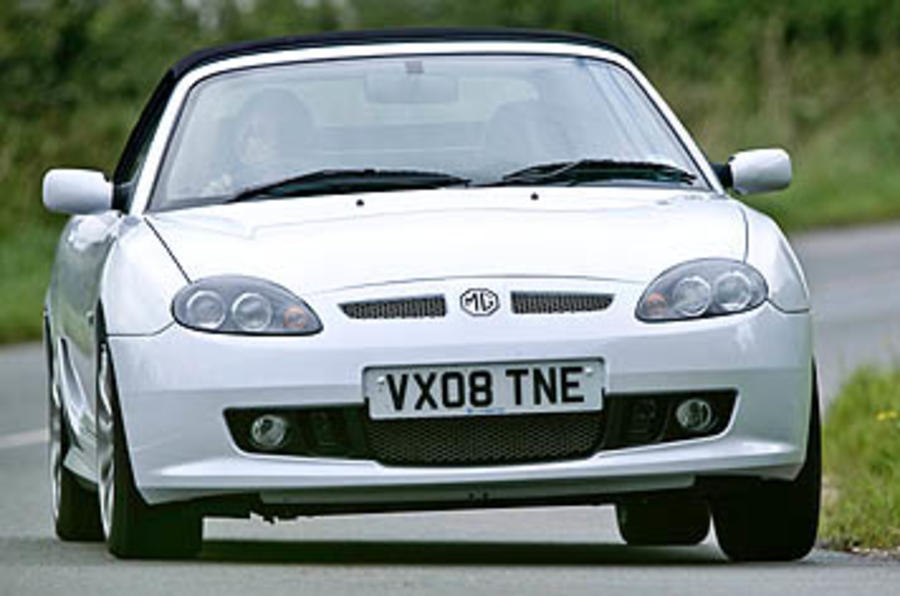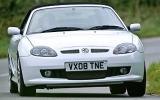What is it?
This is the reborn MG TF, fresh from MG’s Chinese owner, assembled at the Longbridge factory from parts largely sourced from China and featuring the lightest of makeovers.
The revisions consist of a new front bumper and grille assembly, a modernised main instrument pack, an engine that’s been cleaned up to meet Euro4 emissions and modified in (yet another) quest to cure this lightweight motor of its infamously weak headgasket.
Improved hood sealing is said to reduce water leaks, another sporadic MGF/TF problem, and parking sensors are now an option.
Those radar sensors are standard on this introductory LE500 model, which comes with the bulk of the options MG Rover used to offer on the TF for more than £6000 less than they would have cost at the time.
Don’t think that you’ll be driving a car of huge sophistication as a result, though.
Three years ago, when MG Rover went under, air conditioning was an option, as was the LE’s hardtop, leather trim, metallic paint and a bundle of other cosmetic features.
There’s an expensive stereo – an aftermarket Pioneer, whose absurdly small buttons must be the reason for providing a remote control unit in one of the smallest cockpits on the market today – the pedals are alloy and many of the decorative interior mouldings that were once silver are now piano black.
What’s it like?
If you’ve ever sat in a TF, or an MGF, this interior will seem very familiar, right down to a wheel that can only be adjusted for rake, those sunvisors extended by flimsy-looking flaps and the fake allen bolts around the gear lever.
Much of the interior looks old – which it is – and even cheaper than it did when new, partly because that was so long ago.
Still, the new instrument pack – apparently under development at MG Rover when it went down – looks good.
It includes an orange bar graph temperature gauge and even a gearlever change-up light, though the strained sounds emerging from behind your back during the final 500rpm assault to the 7000rpm limiter makes this fairly unnecessary. The absent sixth gear would be useful.
Not a promising start, then. Yet it’s hard not to enjoy actually driving the TF. With only 133bhp it’s not terribly brisk, especially for a sports car. It’s also confined inside and far from quiet. But it’s fun.
The engine, now redubbed ‘N’ Series, sounds eager - even if the only way it will torch asphalt is by self-immolating - the gearlever can be shifted with more accuracy than its rubbery movements suggest, and this compact little car darts about with the kind of zeal that goads you into pushing it harder.
The electric power steering, among the very earliest of the breed, offers more feel than plenty of modern set-ups, and you also get plenty of feedback through the (cheaply) leathered seat.
This latest TF runs the softer standard suspension of the previous MG Rover edition (a good decision; the old sport set-up was far too firm) but the car rides on the bigger, lower-profile 16in rims, producing a compromise set-up that generally works well.







































































Join the debate
Add your comment
Re: MG TF LE500
The MX5 is just an updated version, not a new car either, and the ride and handling not really up to the older MGTF, I would definately buy a good used MGTF, but not an MX5, the new MGTF and has some very good points, and it is not expensive compared to the MX5 . Improvements will come with production and I hope that they produce and sell enough cars, which they deserve , to establish car manufacture on a reasonable scale, I have owned and competed in MG`s in the past, and never been disapointed, unlike the Mazda`s I`ve owned
Re: MG TF LE500
With respect, by your logic, nobody would ever buy a new car. Clearly that isn't the case. The only discussion worth having is one where we compare the options available to those who have chosen - for whatever reason - to buy new. That is the market.
As to your specific points:
- The Elise is too wide for the roads I wish to drive it on, has too poor a hood, no luggage space, and so on.
- The '07 MX-5 is too long IMHO for the interior space provided, and is not a mid-engined car (so offers a different dynamic experience).
If they still made them, I'd have a Suzuki Capuccino or a Smart Roadster, but those are not options any longer.Re: MG TF LE500
Sorry, Ling, but why? And please ensure you consider the cost of delivering a manufactured car to a UK customer, not just the cost of making it in the first place.
The MG TF is NOT being made in China. The body-in-white is being made in China AFAIK and being transported here. Some components are being made in China, too. But assembly is taking place in the UK.
Shipping costs (by sea) are as much related to volume as to weight - the weight (within reason) is fairly irrelevant, as the sea looks after propping that bit up, but the volume of the ship is fixed.
Therefore shipping cars, or shells, from China to the UK is not a cheap proposition. Since you can't really fill up the shell with, say, wheat, you're shipping a lot of air. That makes it very expensive, even though higher-value items (such as engines) can be put in the ship, too.
Meanwhile, Chinese manufacturers are paying more-or-less world prices for steel (in fact, their demand is driving up world steel prices), so a body-in-white operation is not going to be able to save money there. Wages in China are lower, of course, but a combination of lower productivity and rapid Chinese inflation (despite the scandalous way in which "we" have allowed the Chinese government to manipulate the exchange rate), coupled with the shipping costs mentioned above, means that the labour component of a shell at the factory gate in Longbridge is not going to be any cheaper than a UK-produced shell.
Couple this to the state of sterling at the moment, and I'd be surprised if there was any real difference in price.
Well, I'm not sure you're on-the-money there. MGR production stopped because suppliers of key components stopped supplying. The Administrators brought in a small workforce to hand-build as many cars as they could from remaining component stocks. What was left will largely have been taken up with pilot production on the Chinese lines.
In any case, we're not talking about nailing together a handfull of spare-parts cars, we're talking about re-starting production - thousands of cars. The prices have to sustain the actual costs of manufacture.
Don't let the facts get in the way of a good story:) The MG TF line never left Longbridge. The R75 track is also still there, minus one or two finishing stations which went to China. The MG TF assembly was largely hand work in any case - IIRC the only robot was to install the windscreen. I don't know if it is still there.
MGR didn't make the MG TF shells - they were bought in from Stadco (who took over from Mayflower). The nature of the operation at Longridge hasn't changed all that much, I'd say, just the source of some of the parts.
Nissan Sunderland is a very different scale of operation. It does not bear comparison. Most low-volume "mass" producers often don't produce their own shells. Nissan Sunderland started out as a CKD operation, with local content gradually increasing over time. We can hope the same will be true for Longbridge 2.0.
I don't disagree. But you didn't bid to take over MGR, nor did I, nor did anybody else of any merit. If the Chinese are the only ones for whom this is worthwhile economically, welcome to the new world order - after all, you can come to the UK and sell us cars (and rocket launchers?), so where is the difference?
I don't think NAC/SAIC are really chasing your type of operation at the moment - UK production is slated at only a few thousand for the time being. After that? Well, who knows. They've committed in public to a four-model lineup. They have platforms and technology, and (most of) a production track at Longbridge to build up to 120K or so cars per year. There are designs and engineering that they inherited from MGR for a two-model follow-up to the MG TF (new midget using a variant of the existing shell, larger F/TF based on a very heavily modified platform stretch from the existing model), for instance. If they can keep the production costs down, those have potential.
Nobody, but not because Hydragas was "rubbish", but because Dunlop ceased manufacture in (IIRC) 2006 of Hydragas units and scrapped the tooling.
Well, Ling, you came here from China, copied the US model of selling cars, and have made good money at it. I fear you're in the glasshouse throwing stones if you criticise your conuntrymen for copying. Where is your innovation, beyond parking a missile truck at the side of the road?
If you look at the history of car manufacturing nations, the model you describe - copy, improve, evolve, innovate - is the common thread. Even BMW started by making copies of the Austin 7, as did at least one Japanese manufacturer. Hyundai started with a knock-off Ford Cortina, India with the Morris Oxford, and so on. Are you somehow decrying the Germans, the Japanese, and now the Indians (who're buying up western companies at a rate of knots) for having started by making copies?
I really am a little staggered by the whole thrust of your views here!